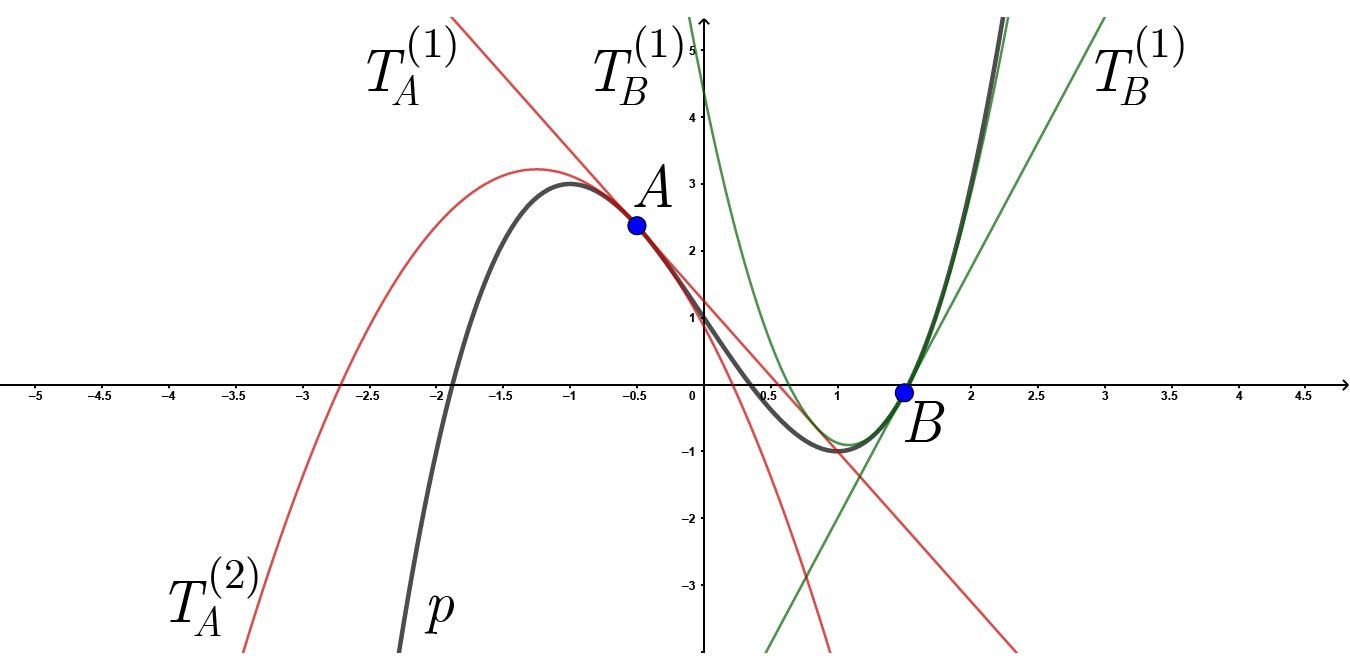NOTE: Full credit goes to N. J. Wildberger for exposing this idea in his DiffGeom playlist, though as pointed out this is in fact a result of Lagrange and (possibly) Euler.
Consider, for example, the polynomial 1−3x+x3 over the rational number field and the evaluation map p from the rational number field to itself given by p(α)≡1−3α+α3.
To evaluate the Taylor polynomial of the example polynomial at a particular value α=r we first compute p(α+r), which, after collecting the terms with respect to powers of α, gives us
p(α+r)=1−3(α+r)+(α+r)3=(1−3r+r3)+(−3+3r2)α+(3r)α2+α3≡q(α).
If we define Tr(k)p(α)≡q(α−r) to be the kth Taylor polynomial centred at α=r, then we obtain
Tr(0)p(α)=p(r),
Tr(1)p(α)=(1−3r+r3)+(−3+3r2)(α−r)=(1−2r3)+(−3+3r2)α,
Tr(2)p(α)=(1−3r+r3)+(−3+3r2)(α−r)+(3r)(α−r)2=(1+r3)+(−3−3r2)α+3rα2
and
Tr(3)p(α)=p(α).

Interpreting the results geometrically (see the picture above, where A≡[−21,819] and B≡[23,−81]), we have that Tr(1)p(α) and Tr(2)p(α) correspond respectively to the tangent line and the tangent conic of p(α). This will generalise for any (finite-degree) polynomial. Furthermore, for a polynomial of degree n with evaluation map p, we have that Tr(0)p(α)=p(r) and Tr(n)p(α)=p(α).
So, we have here a purely geometric/algebraic framework for differential calculus, which really just boils down to understanding tangents. The framework provided will generalise not only to arbitrary fields but also for algebraic curves, as well as surfaces. In fact, this framework would provide a firm foundation for differential geometry, which is really just the study of curves and surfaces.
#Calculus

Easy Math Editor
This discussion board is a place to discuss our Daily Challenges and the math and science related to those challenges. Explanations are more than just a solution — they should explain the steps and thinking strategies that you used to obtain the solution. Comments should further the discussion of math and science.
When posting on Brilliant:
*italics*or_italics_**bold**or__bold__paragraph 1
paragraph 2
[example link](https://brilliant.org)> This is a quote# I indented these lines # 4 spaces, and now they show # up as a code block. print "hello world"\(...\)or\[...\]to ensure proper formatting.2 \times 32^{34}a_{i-1}\frac{2}{3}\sqrt{2}\sum_{i=1}^3\sin \theta\boxed{123}Comments
I think polynumbers need its own wiki-page... anytime I see polynomial now I can't help but think about a polynumber.
Keeping in mind that they are just lists definetly keeps my mind more engaged on reading something that clearly is at the forefront of something special, to say the least.
Log in to reply
I agree 100%. I'm keeping it simple by applying the common mathematical tools. P.S. Have you been following his Algebraic Calculus course?
Log in to reply
I have been watching the videos and poking my head into the course, hopefully over the year I can work on more of the material.
I still think that we can give a much more focused and efficient tour of calculus if we focus on small fields. People will feel less overwhelmed by the incredible power of the tools that are being presented.
My point: People are enamoured with Machine Learning (just ask any of my students in high school... it sounds very interesting) but when they realize the amount of mathematics involved they shy away(for the most part. Its a shame really.
I sometimes feel like Norman is holding back on us as he clearly sees the potential for explaining things with finite fields(just look at his book) but he seems to give in to pressure.
Also the biggest weakness of rat-trig is the characteristic two field of less limitation.
For someone so focused on the fundamentals of mathematics those fields of low characteristic are the most important as they define numeration, succession, inverse.
He clearly made huge strides with "A new look at multi-set theory" but it seems like something is missing... as he usually ends his papers with a well written conclusion... that one trails off... a little. In that it ends in a proof, as opposed to a summarizing note to the reader on where to go next.
Log in to reply
I think ML, like BD, is a big sham. Aside from the ethical considerations, I wholly reject the notion that machines can truly achieve the same capabilities as a human does.
Given how easy it is to steal one's ideas and pass it off as their own in this crappy online world, I think he has that right to hold back. I do the same with my YouTube channel; why do you think I haven't been uploading as many videos as I did at the start? I can discuss this further, but not on a public forum.
I don't think it's as big as you claim it is. Avoiding characteristic 2 fields is compatible with Wildberger's Zero denominator convention, but your scope of study is not that limited. It's more that RT sidesteps from the traditional progression of mathematics so much that in order to truly understand it you would have to turn the whole curricula of mathematics upside down.
Nonetheless, good points you have brought up; clearly shows you're paying attention to what's out there!
You can start a Wiki about it.